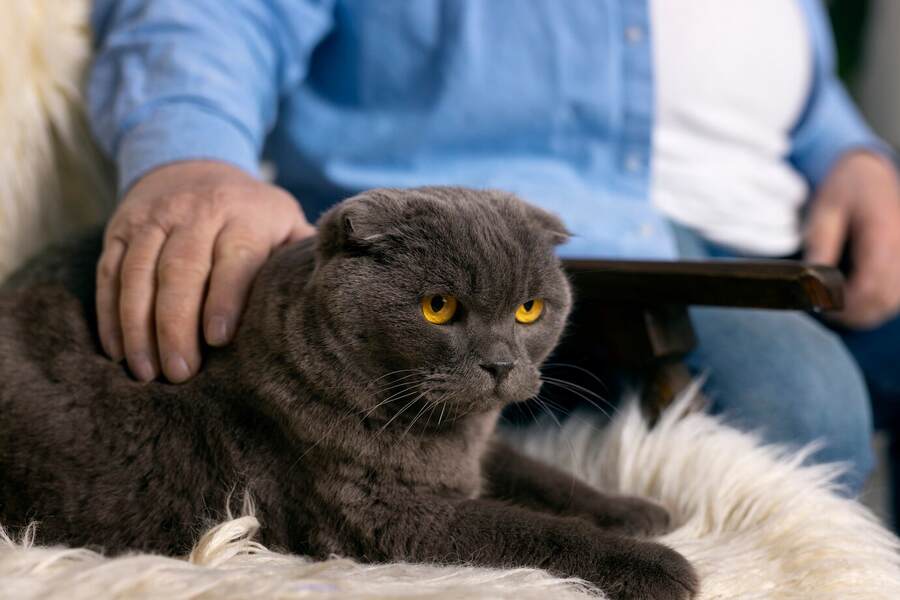The World Wide Web is showing some images and videos of cats exhibiting very distinctive facial expressions and mannerisms in recent years. These hybrids, also known as “Down Syndrome cats,” have become an online sensation on platforms such as Instagram and TikTok. Their unique looks, wide-spaced eyes, flat noses, and exaggerated expressions have many thinking that these cats have Down Syndrome. However, they are founded more on appearance than reality. Here, we will discuss some of the very important points about a cat with Down Syndrome.
Understanding Down Syndrome in Humans
What Is Down Syndrome?
Down Syndrome is a genetic disorder resulting from a third copy of chromosome 21, either full or partial. This extra genetic material alters the course of development. It results in characteristic physical features and developmental delays. Characteristic features may include low muscle tone, short stature, upward slanting eyes, and a single deep crease in the center of the palm.
Chromosomal Basis: Trisomy 21
People typically have 23 pairs of chromosomes, totaling 46. People with Down Syndrome have an extra copy of chromosome 21, for a total of 47 chromosomes. This condition is called Trisomy 21 and interferes with normal growth and is responsible for the characteristics of Down Syndrome. This extra chromosome creates multiple impacts on the body.
Feline Genetics Explained
Chromosomes of Cats vs. Humans
Cats do not have the same chromosomes as humans. We have 23 pairs of chromosomes; they have 19 (38 chromosomes). This essential difference cannot lead to Trisomy 21 or Down Syndrome in cats, since they do not have a chromosome 21, and cats are trisomic for multiple chromosomes as it is.
Trisomy 21 in Cats: Can Cats Have Down Syndrome?
Cats don’t have a chromosome 21, so they cannot have the same genetic duplication that leads to Down Syndrome in humans. There are some cat genetic mutations and chromosomal errors that can provide mixed information, and others that have hormones and/or antibodies. It interferes with developmental processes. Thus, the appearances and behavior of a cat with Down Syndrome are not of the human condition.
The Myth Of the Cat with Down Syndrome
Origins of the Misconception
“Cat with Down Syndrome” is probably a result of well-meaning people trying to explain the unusual behavior of their cat. This misconception has been popularized through social media, where mass-shared images of cats exhibiting peculiar feline forms are shared along with captions. It misinforms the viewer that the cat in question has Down Syndrome. However, this is not an accurate scientific term, and it can lead to confusion in discussions about cat health.
Famous Cats Falsely Accused of Down Syndrome
Several cats have gained considerable fame due to their distinctive appearance. Monty, a cat in Denmark, for example, has a small nasal bridge and wide-spaced eyes that have led to comparisons with Down Syndrome. Similarly, Maya, a cat with a chromosomal defect, has earned the moniker of “Down syndrome cat” despite no scientific evidence supporting this. These examples illustrate the importance of precision, comprehension, and terminology used in describing feline diseases and health.
Cats with Down Syndrome-like Symptoms
Cerebellar Hypoplasia
The cerebellum, which controls coordination and balance, is not entirely formed in cerebellar hypoplasia. Cats that suffer from this condition typically present with ataxia, tremors, and impaired coordination while walking. Their physical symptoms might look very similar to things you’d see in someone with Down Syndrome, but “cerebellar hypoplasia” is its own, separate disease with its causes and treatments.
Hydrocephalus
Water on the brain: Hydrocephalus is the excessive accumulation of cerebrospinal fluid in the brain. This can lead to your cat having an enlarged head, seizures, and eye problems. Some people think the physical traits resemble those of Down Syndrome, but hydrocephalus is another medical problem.
Feline Dysautonomia
Feline dysautonomia (Key-Gaskell syndrome) is an uncommon disorder of the autonomic nervous system. These symptoms consist of, but are not limited to, dilated pupils, third eyelid protrusion, and gastrointestinal problems. The condition can change her looks and demeanor in ways that might result in misunderstandings about Down Syndrome. Dysautonomia, however, is not associated with the chromosomal defects found in human Down Syndrome.
Other Genetic and Inborn Errors Of Cats with Down Syndrome
Cats can also be born with a variety of genetic or congenital conditions. It may affect their physical or neurological development. Disorders of craniofacial structure, limbs, or senses may cause signs or behaviors that can be misclassified as Down syndrome. It is essential to treat these as separate medical issues requiring veterinary care.
Identifying Down Syndrome-like Symptoms in Cats
Physical Traits
These can include:
- Broad or flat nasal bridges
- Wide-set or misaligned eyes
- Small or misshapen ears
- Short limbs or abnormal gait
Although these characteristics sound similar to what occurs with human Down syndrome, they are actually caused by different genetic and biochemical processes in cats.
Behavioral Indicators
- Slowed growth or problems with learning
- Unusual vocalizations
- Decreased reactivity to stimuli
- Problems with litter box training
Neurological Signs
Neurological symptoms that might be misdiagnosed as Down Syndrome symptoms are:
- Seizures
- Head tilting
- Uncoordinated movements
- Tremors
These signs are indicative of possible nervous system malfunction and require a full medical investigation to diagnose the cause.
Conclusion
Although “Cat with Down Syndrome” has become a theme in internet lore, it’s essential to note that cats cannot have Down Syndrome, given the genetic differences. However, there are a number of medical conditions that can cause physical and intellectual characteristics similar to those found in people with Down Syndrome. It is essential to identify and diagnose these conditions, as patients require appropriate care and support. Through education and empathy, we can help all cats, regardless of their special needs, live happy and comfortable lives.
FAQs
Can cats have Down Syndrome?
No, you can‘t get Down syndrome from a cat, since they have 21 chromosomes. They may have conditions that resemble some physical or behavioral symptoms, but these aren’t genetically identical.
What are the symptoms of a cat with Down Syndrome?
Various conditions, such as cerebellar hypoplasia, hydrocephalus, craniofacial malformations and other congenital diseases, can cause cats to have some characteristics resembling those associated with Down Syndrome. These impact how the cat’s body is put together, its motor skills and sometimes behavior.
What can I do for my special-needs cat?
Begin with the right diagnosis by your veterinarian, so you know what condition you have. And then tailor the environment to their abilities: offer safe spaces, low-entry litter boxes, a predictable routine, and visit your vet regularly. Most of all, give unconditional love and patience.
Are there tests to diagnose genetic diseases in cats?
Yes, there is such a thing as cat genetics, although it’s not as well-developed as in the study of human genetics. It can aid in diagnosing certain inherited diseases. Imaging studies and neurological evaluations can also be helpful in detecting congenital or developmental problems.
Should I adopt a cat with special needs?
Sure, if you’re down for the commitment. Special-needs cats can be just as loving, adaptable, and endearing as any other. They might require special care, but the emotional and spiritual rewards are beyond measure.





